中考英语语法复习(陈述句、疑问句、祈使句、感叹句、倒装句)
- 格式:doc
- 大小:27.00 KB
- 文档页数:4
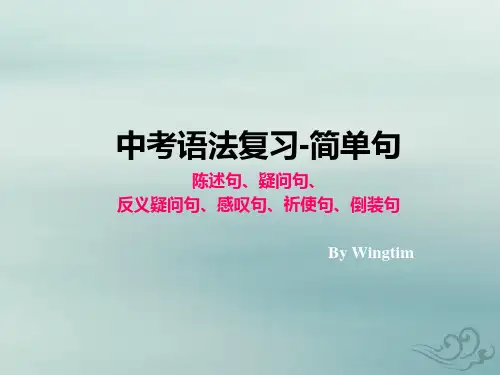
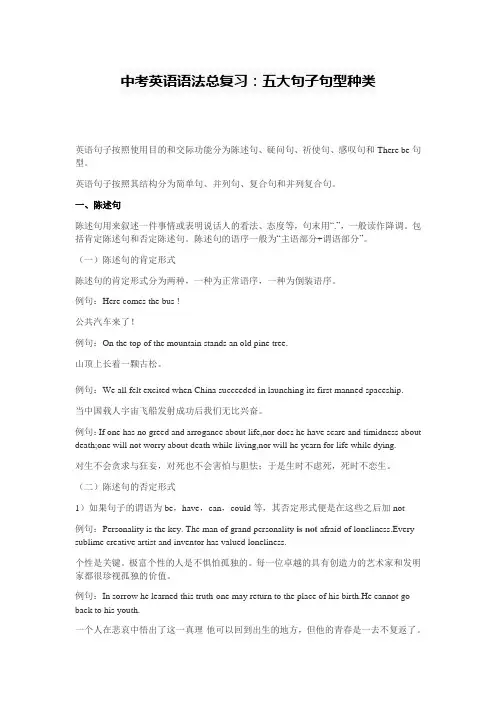
中考英语语法总复习:五大句子句型种类英语句子按照使用目的和交际功能分为陈述句、疑问句、祈使句、感叹句和There be句型。
英语句子按照其结构分为简单句、并列句、复合句和并列复合句。
一、陈述句陈述句用来叙述一件事情或表明说话人的看法、态度等,句末用“.”,一般读作降调。
包括肯定陈述句和否定陈述句。
陈述句的语序一般为“主语部分+谓语部分”。
(一)陈述句的肯定形式陈述句的肯定形式分为两种,一种为正常语序,一种为倒装语序。
例句:Here comes the bus !公共汽车来了!例句:On the top of the mountain stands an old pine tree.山顶上长着一颗古松。
例句:We all felt excited when China succeeded in launching its first manned spaceship.当中国载人宇宙飞船发射成功后我们无比兴奋。
例句:If one has no greed and arrogance about life,nor does he have scare and timidness about death;one will not worry about death while living,nor will he yearn for life while dying.对生不会贪求与狂妄,对死也不会害怕与胆怯;于是生时不虑死,死时不恋生。
(二)陈述句的否定形式1)如果句子的谓语为be,have,can,could等,其否定形式便是在这些之后加not例句:Personality is the key. The man of grand personality is not afraid of loneliness.Every sublime creative artist and inventor has valued loneliness.个性是关键。

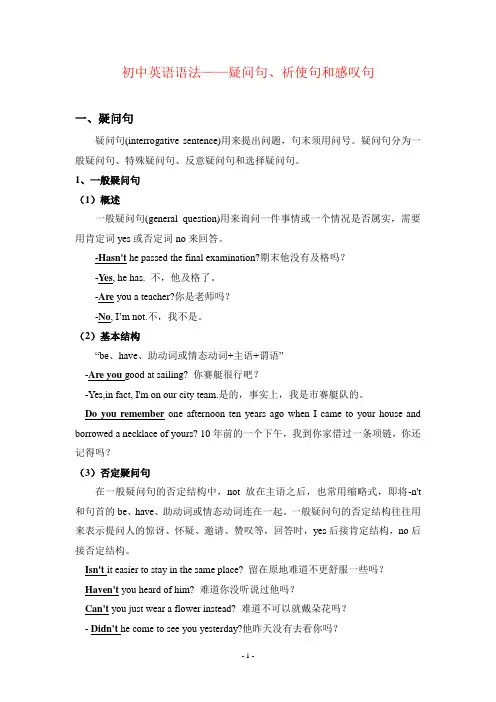
初中英语语法——疑问句、祈使句和感叹句一、疑问句疑问句(interrogative sentence)用来提出问题,句末须用问号。
疑问句分为一般疑问句、特殊疑问句、反意疑问句和选择疑问句。
1、一般疑问句(1)概述一般疑问句(general question)用来询问一件事情或一个情况是否属实,需要用肯定词yes或否定词no来回答。
-Hasn't he passed the final examination?期末他没有及格吗?-Yes, he has. 不,他及格了。
-Are you a teacher?你是老师吗?-No, I’m not.不,我不是。
(2)基本结构“be、have、助动词或情态动词+主语+谓语”-Are you good at sailing? 你赛艇很行吧?-Yes,in fact, I'm on our city team.是的,事实上,我是市赛艇队的。
Do you remember one afternoon ten years ago when I came to your house and borrowed a necklace of yours? 10年前的一个下午,我到你家借过一条项链,你还记得吗?(3)否定疑问句在一般疑问句的否定结构中,not放在主语之后,也常用缩略式,即将-n't 和句首的be、have、助动词或情态动词连在一起。
一般疑问句的否定结构往往用来表示提问人的惊讶、怀疑、邀请、赞叹等,回答时,yes后接肯定结构,no后接否定结构。
Isn't it easier to stay in the same place? 留在原地难道不更舒服一些吗?Haven't you heard of him? 难道你没听说过他吗?Can't you just wear a flower instead? 难道不可以就戴朵花吗?- Didn't he come to see you yesterday?他昨天没有去看你吗?-No, he didn't.是的,他没来。
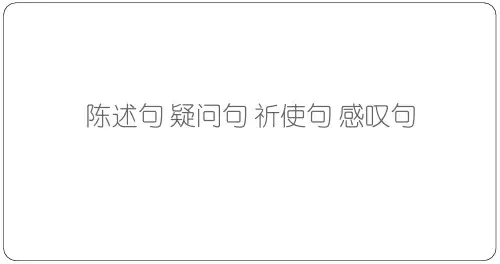
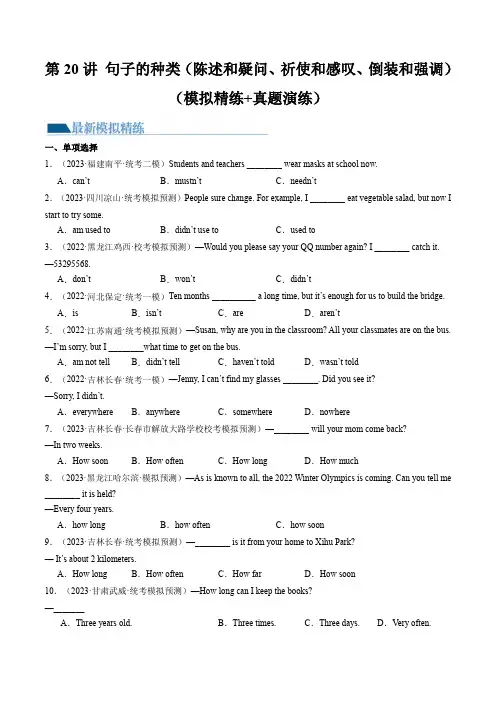
第20讲句子的种类(陈述和疑问、祈使和感叹、倒装和强调)(模拟精练+真题演练)一、单项选择1.(2023·福建南平·统考二模)Students and teachers ________ wear masks at school now.A.can’t B.mustn’t C.needn’t2.(2023·四川凉山·统考模拟预测)People sure change. For example, I ________ eat vegetable salad, but now I start to try some.A.am used to B.didn’t use to C.used to3.(2022·黑龙江鸡西·校考模拟预测)—Would you please say your QQ number again? I ________ catch it.—53295568.A.don’t B.won’t C.didn’t4.(2022·河北保定·统考一模)Ten months __________ a long time, but it’s enough for us to build the bridge.A.is B.isn’t C.are D.aren’t5.(2022·江苏南通·统考模拟预测)—Susan, why are you in the classroom? All your classmates are on the bus.—I’m sorry, but I ________what time to get on the bus.A.am not tell B.didn’t tell C.haven’t told D.wasn’t told6.(2022·吉林长春·统考一模)—Jenny, I can’t find my glasses ________. Did you see it?—Sorry, I didn’t.A.everywhere B.anywhere C.somewhere D.nowhere7.(2023·吉林长春·长春市解放大路学校校考模拟预测)—________ will your mom come back?—In two weeks.A.How soon B.How often C.How long D.How much8.(2023·黑龙江哈尔滨·模拟预测)—As is known to all, the 2022 Winter Olympics is coming. Can you tell me ________ it is held?—Every four years.A.how long B.how often C.how soon9.(2023·吉林长春·统考模拟预测)—________ is it from your home to Xihu Park?— It’s about 2 kilometers.A.How long B.How often C.How far D.How soon10.(2023·甘肃武威·统考模拟预测)—How long can I keep the books?—_______A.Three years old.B.Three times.C.Three days.D.Very often.11.(2023·甘肃平凉·校考模拟预测)—________ are you going to the airport?—By bus.A.What B.How C.When D.Why12.(2023·吉林长春·模拟预测)Take action now, ________ you can’t achieve your goal.A.but B.so C.and D.or13.(2023·吉林·模拟预测)—Mary, ________ worry about what to wear today. Your smile goes with any clothes.—Thank you, Mom.A.not B.don’t C.doesn’t14.(2023·福建龙岩·统考模拟预测)Tony, ________ to the front door to see who is knocking.A.go B.goes C.to go15.(2023·福建漳州·校联考模拟预测)Work hard, ________ you’ll find a way out.A.so B.or C.and16.(2023·吉林长春·统考一模)Please ________ back to your seat, Yu Jun. You did a good job.A.go B.to go C.going D.gone17.(2023·江西九江·统考二模)Hurry up, ________ we will miss the last subway.A.but B.and C.or D.so18.(2023·重庆长寿·校联考一模)Please ________ make any noise in the library. It will disturb others.A.don’t B.not to C.not D.won’t19.(2023·湖南株洲·统考一模)________ terrible weather it is! It is said that it will get sunny later.A.What B.How C.What a20.(2023·湖南株洲·统考二模)John! You’ve passed the exam. ________ pleasant surprise you gave us!A.How B.What a C.What21.(2023·海南·校联考二模)—Our school won the soccer game this afternoon!—________ exciting news it is! We are all happy about it.A.What B.What an C.How22.(2023·甘肃定西·统考模拟预测)______ wonderful time they were having in the town at this time yesterday afternoon!A.What a B.What C.How a D.How23.(2023·吉林长春·统考一模)— Look! All the trees are green now.— ________ fresh spring morning it is!A.How B.What C.What a D.What an24.(2023·吉林长春·统考一模)Look at the little cat over there! ________ lovely it is!A.What a B.What C.How a D.How25.(2023·江苏宿迁·校联考三模)________ information we can get from the Internet! Thanks to the excellent website.A.What useful B.What a useful C.How useful D.How useless26.(2023·重庆沙坪坝·重庆八中校考三模)________ delicious and cheap Zibo food is! You’d better have a try.A.How B.How a C.What D.What a27.(2023·重庆沙坪坝·重庆八中校考二模)—_______ exciting time we had during the Water Festival!—Yeah! I hope we can come back next year.A.What B.How C.What an D.How an28.(2023·吉林长春·统考一模)________ hard Tim was working on his homework! He even didn’t notice his mom enter the room.A.How B.How a C.What D.What a29.(2023·甘肃武威·统考模拟预测)— I didn’t go to Tom’s birthday party yesterday. What about you?—________, because I was preparing for the exam all the time.A.Nor do I B.Neither did I C.Neither am I D.Nor was I30.(2023·江苏淮安·校考一模)—I will not give up my dreams though there are many difficulties.—________.A.So will I B.Neither will IC.Neither won’t I D.So won’t I31.(2023·甘肃天水·天水市逸夫实验中学校考模拟预测)—I’d love to go hiking with you, but I have much homework ________.—If you don’t go, ________.A.doing;so do I B.to do;neither will IC.to doing;so will I D.to do;neither do I32.(2023·西藏日喀则·统考二模)—Will you go to the Max City tomorrow?—If you don’t go, ________.A.so do I B.so will I C.neither do I D.neither will I33.(2023·黑龙江齐齐哈尔·统考三模)—Would you like to go camping with us this Sunday?—If Jim goes, ________.A.so do I B.so will I C.so I will34.(2023·安徽合肥·校考一模)—Oh, dear. You have stepped on my foot.—Oh, ________. I’m terribly sorry.A.so have I B.so did I C.so I have D.so I do35.(2022·黑龙江绥化·校考模拟预测)—It’s such a wonderful experience!—________ I hope I can come to do it next time!A.So it is.B.So is it.C.So does it.36.(2020·安徽合肥·合肥市第四十二中学校考一模)—Wang Hong speaks English very well.—_______. She can talk with Americans freely.A.So she does B.So does she C.Neither she does D.Neither does she 37.(2020·湖南长沙·长沙麓山国际实验学校校考三模)— Father, you promised!—Well, _______. But it was you who didn’t keep your word first.A.so I was B.so I did C.so have I38.(2021·云南曲靖·统考一模)—Mr. Li is a great teacher. He gave really clear instructions during his class. —________. I admire him so much.A.So he did B.So did he C.So it was D.So was it39.(2023·吉林四平·校联考三模)—The young man seldom did the housework after he bought the robot,________?—No. He could relax and have time to practise “Shuttlecock Exercise” (毽子操).A.did he B.didn’t he C.was he40.(2023·山东菏泽·统考三模)—________ you ever ________ The Great Wall of China?—No, I haven’t. I hope I can go there next year.A.Did; go to B.Have; been to C.Have; gone to二、语法选择(2023·广东广州·统考二模)There was a king who loved art. One day an artist came and hoped to paint a picture on 41 wall. The king happened to have a big new hall built 42 he allowed the artist to work on one of the walls.At the same time, 43 artist came and asked to work on the opposite wall. He promised to make the same picture as the first artist’s without 44 at it. He asked to have a thick cloth 45 can be put up between the two walls so that neither of them could see each other.The following day they started 46 . The first artist 47 paint, oil, water and so on. The second one came with a towel and a bucket.A month later, the first artist’s work 48 , and the second artist said, “My wall 49 ready, too!”The king went to see the first artist’s wall. He was very 50 with it and gave the artist a lot of money. He then opened the cloth.Amazing! Each line was exactly the same as that on the opposite wall. The king was quite satisfied with the second artist and gave 51 double money. However, he wondered 52 he had made it. “I just wipe the wall with the towel,” the man said 53 . The wall was made 54 white marble (大理石). He made it shine like a mirror. The reflection (倒影) of the first painting showed up on it!The world is also a reflection of you. 55 you are sad, the world will be sad. You are happy and the world will be happy, too.41.A.a B.an C.the D.I42.A.or B.so C.but D.because43.A.other B.others C.the others D.another44.A.look B.looks C.looking D.looked一、单项选择1.(2023·西藏·统考中考真题)—Luosang, ________—I went there by plane.A.why did you go to Lhasa?B.when did you go to Lhasa?C.how did you go to Lhasa?D.who did you go to Lhasa with?2.(2023·西藏·统考中考真题)—You look so young. Are you a student?—________. I’m a student from China.A.Yes, I do B.Yes, I am C.No, I don’t D.No, I won’t 3.(2023·辽宁阜新·统考中考真题)—________ does the museum open at weekends?—At 9:00 am.A.How B.Where C.Why D.When4.(2023·江苏南通·统考中考真题)—Excuse me, ________ is the Gengsu Theatre from this hotel?—It’s about ten minutes if you take a taxi.A.how far B.how long C.how soon D.how much5.(2023·辽宁抚顺·统考中考真题)— ________ have you been a member of the football team?—For two years.A.How much B.How often C.How many D.How long6.(2023·吉林长春·统考中考真题)— Which season do you like better in Changchun, winter or autumn?— _______. I like playing with snow.A.Yes, I do B.No, I don’t C.Winter D.Autumn7.(2023·黑龙江·统考中考真题)—You haven’t visited the Palace Museum, have you?—________ How I wish to visit it some day!A.No, I haven’t.B.Yes, I haven’t.C.Yes, I have.8.(2022·广西桂林·统考中考真题)—Will she come back soon?—Yes, ________.A.she is B.she will C.she does9.(2022·四川·统考中考真题)—________ is it from your home to school, Peter?—Only ten minutes’ walk.A.How long B.How often C.How far D.How soon 10.(2022·江苏淮安·统考中考真题)— ________ do you visit your grandparents, Simon?— Twice a month.A.How often B.How soon C.How long D.How much11.(2022·上海·统考中考真题)—There is an umbrella in the corner of the classroom. ________ is it? —Perhaps it’s Mary’s.A.Whose B.Who C.When D.Why12.(2022·黑龙江绥化·统考中考真题)Jean knew nothing about the news until her aunt told her, ________________?A.didn’t; she B.did; she C.didn’t; Jean13.(2022·黑龙江·统考中考真题)—Mum, let’s order some food online for dinner, ________?—Good idea. I’d like some beef dumplings.A.will you B.won’t you C.shall we14.(2022·吉林长春·统考中考真题)— Do you like travelling by train or by plane?— ________. Because I love to see farms and animals along the way.A.Yes, I do B.No, I don’t C.By train D.By plane15.(2022·山东济南·统考中考真题)—Dad, shall we go to the library by bike or by car?—________. There is no parking lot there.A.Yes, we will B.No, we won’t C.By car D.By bike16.(2022·上海·统考中考真题)Have a balanced diet and exercise regularly _______ you will stay healthy.A.and B.or C.but D.for17.(2022·西藏·统考中考真题)Don’t ________ any noise when you are in the library.A.makes B.make C.making D.made18.(2022·吉林长春·统考中考真题)Don’t throw rubbish everywhere, ________ our environment will get worse.A.but B.so C.and D.or19.(2022·辽宁盘锦·统考中考真题)Don’t run in the hallways, ________ you might get hurt.A.and B.but C.so D.or20.(2022·四川广元·统考中考真题)— ______ silent, please! You are in the library.—I’m sorry, madam.A.Keep B.To keep C.Keeping D.Kept21.(2022·四川遂宁·统考中考真题)—Sam, ________ run in the hallways. It’s very dangerous.—Sorry, Ms. Black.A.do B.don’t C.not D.doesn’t22.(2023·辽宁鞍山·统考中考真题)—The pen can translate what you write down into English.—________ interesting invention!A.What B.What an C.How D.What a23.(2022·内蒙古·中考真题)—Have you heard that Mr. Zhang saved his neighbor from a big fire last night?—Yes. ________ brave the young man is!A.What a B.How C.What D.How a24.(2022·江苏淮安·统考中考真题)________ good book you offered us! It really helps us a lot.A.How B.How a C.What D.What a25.(2022·上海·统考中考真题)_______ exciting singing contest they had yesterday!A.What B.How C.What an D.How an26.(2022·辽宁鞍山·统考中考真题)—China launched(发射)the manned spacecraft Shenzhou-14 successfully on June 5, 2022.—________ exciting news! We are proud of it.A.What B.What an C.How D.How an27.(2022·辽宁锦州·统考中考真题)Bing Dwen Dwen is one of the 2022 Winter Olympic mascots(吉祥物). ________ lovely it is!A.What a B.How C.What an D.What28.(2021·西藏·统考中考真题)—She’s never read the book Journey to the West. How about you?— ________ .A.So am I B.Neither have I C.So have I D.Neither do I29.(2022·贵州铜仁·统考中考真题)— Li Ping, I didn’t go summer camping last year.— _________.A.So did I B.Neither did I C.Neither I did D.So I did30.(2020·辽宁丹东·统考中考真题)—Tom is always ready to help others.—________. He often helps me with my English.A.So he is B.So he does C.So is he D.So does he二、语法选择What do you think of your parents? I am always very pleased 31 them. 32 I have grown up,I act like a small child sometimes. This feeling lets me 33 free and relaxed. In my opinion, things seem34 in the world of adults’ than those of children’s.One day, I went to buy some Christmas cards for my friends. After I went in, the shop-keeper showed me 35 I could choose the cards. I met a young mother and her baby there.There 36 a lot of toys on the shelf. It was 37 high that the little girl was not able to pick up a toy. The young mother tried 38 by the shelf closely, but it was still too difficult for the little girl. Then the young mother stopped. She picked up a toy for her child and made her 39 .The big smile 40 was on the face of the little girl made me think of my childhood. When I was a small child, my parents came along whenever I needed them. Almost every problem 41 for me. I almost got lost in that happy memory. Suddenly, the young mother’s words brought me back to 42 .“Dear, one day, when you become 43 adult, I hope you can manage your own life, ” she said to the little girl.The words woke 44 up. I was no longer a small child. I should learn to be independent and faceproblems 45 by myself. And my parents would certainly be proud of me. 31.A.at B.with C.for D.to 32.A.Whether B.If C.Although D.When 33.A.feel B.to feel C.feeling D.felt 34.A.much difficult B.more difficult C.most difficult D.the most difficult 35.A.when B.what C.who D.where 36.A.are B.were C.is D.was 37.A.so B.too C.very D.such 38.A.pass B.passed C.passes D.to pass 39.A.happy B.happily C.happiness D.happiest 40.A.what B.who C.why D.which 41.A.was solving B.were solving C.was solved D.were solved 42.A.reality B.real C.really D.realize 43.A.a B.an C.the D./44.A.I B.my C.mine D.me 45.A.brave B.braver C.bravely D.bravery。
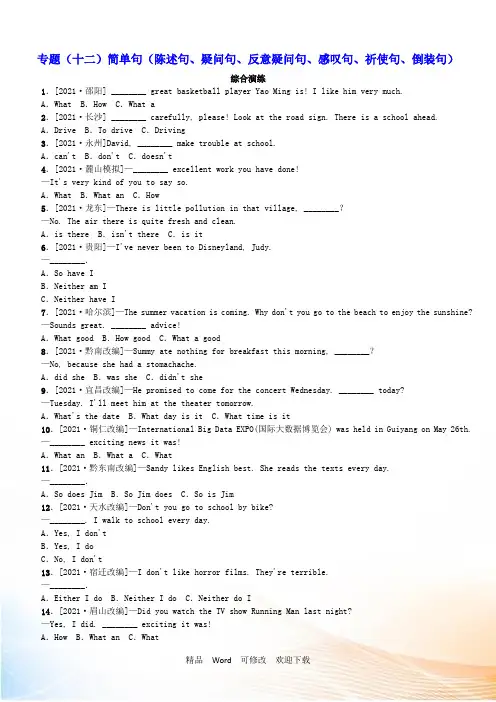
专题(十二)简单句(陈述句、疑问句、反意疑问句、感叹句、祈使句、倒装句)综合演练1.[2021·邵阳] ________ great basketball player Yao Ming is! I like him very much.A.What B.How C.What a2.[2021·长沙] ________ carefully, please! Look at the road sign. There is a school ahead. A.Drive B.To drive C.Driving3.[2021·永州]David, ________ make trouble at school.A.can't B.don't C.doesn't4.[2021·麓山模拟]—________ excellent work you have done!—It's very kind of you to say so.A.What B.What an C.How5.[2021·龙东]—There is little pollution in that village, ________?—No. The air there is quite fresh and clean.A.is there B.isn't there C.is it6.[2021·贵阳]—I've never been to Disneyland, Judy.—________.A.So have IB.Neither am IC.Neither have I7.[2021·哈尔滨]—The summer vacation is coming. Why don't you go to the beach to enjoy the sunshine? —Sounds great. ________ advice!A.What good B.How good C.What a good8.[2021·黔南改编]—Summy ate nothing for breakfast this morning, ________?—No, because she had a stomachache.A.did she B.was she C.didn't she9.[2021·宜昌改编]—He promised to come for the concert Wednesday. ________ today?—Tuesday. I'll meet him at the theater tomorrow.A.What's the date B.What day is it C.What time is it10.[2021·铜仁改编]—International Big Data EXPO(国际大数据博览会) was held in Guiyang on May 26th. —________ exciting news it was!A.What an B.What a C.What11.[2021·黔东南改编]—Sandy likes English best. She reads the texts every day.—________.A.So does Jim B.So Jim does C.So is Jim12.[2021·天水改编]—Don't you go to school by bike?—________. I walk to school every day.A.Yes, I don'tB.Yes, I doC.No, I don't13.[2021·宿迁改编]—I don't like horror films. They're terrible.—________.A.Either I do B.Neither I do C.Neither do I14.[2021·眉山改编]—Did you watch the TV show Running Man last night?—Yes, I did. ________ exciting it was!A.How B.What an C.What15.[2021·烟台改编]—________?—She is of medium height with two blue eyes.A.How is RitaB.What does Rita likeC.What does Rita look like16.[2021·临沂改编] ________ amazing concert Li Yundi gave in Linyi!A.How an B.How C.What an17.[2021·随州改编]—Is the mobile phone new or old?—________. I bought it only two days ago.A.It's old B.It's new C.Yes, it is18.[2021·济宁改编]—________ wonderful the speech is!A.How B.What C.What a19.[2021·天津改编]—Which do you prefer, traditional Western music ________ pop music?—Pop music.A.but B.as C.or20.[2021·宿迁改编]—Have you heard that Lin Tao saved his neighbor from a big fire last night? —Yes. ________ brave young man he is!A.How B.What a C.What21.[2021·盐城改编] ________ fine weather it is! Let's go on a picnic!A.What a B.What C.How22.[2021·南京改编]—Excuse me, but can you tell me where the nearest bank is?—Just ________ going for two more blocks and you'll see it.A.keep B.to keep C.keeping23.[2021·连云港改编]—________ delicious food you served us tonight! Thank you very much!—I'm glad that you enjoyed it.A.How B.What a C.What24.[2021·黔东南改编]Your mother is very busy. She hardly does morning exercises, ________?A.isn't she B.does she C.is she25.[2021·达州改编]—________ kind of tea would you like?—I love tea ________ has a fruity taste.A.Which; what B.What; which C.Whose; that26.[2021·随州改编] ________ important it is for kids to imagine freely!A.What B.How C.What an27.[2021·白银改编]—Our classmates are going to Fantawild Adventure(方特欢乐世界) after the exams. —________ exciting idea!A.What B.What an C.How28.[2021·绥化]Mr. Green is ________ old to carry the heavy box.A.to B.very C.too29.[2021·鄂州改编]—He didn't go to school late yesterday, did he?—________, though it rained hard yesterday.A.No, he didn'tB.Yes, he didn'tC.Yes, he did30.[2021·恩施]—The weather changes often in June.—________. The highest temperature yesterday was 32°C, but it's just 18°C today.A.So it isB.So it doesC.So does it31.[2021·黄冈改编]—I missed the match between Ma Long and Fan Zhendong last night. ________, May? —Amazing! It's the most exciting match of the world table tennis.A.Can I help youB.What's it likeC.What's it about32.[2021·绥化] ________ long sentence!A.What B.What a C.How33.[2021·宜昌改编]—People choose highspeed train or selfdriving to travel on holiday.—________ fast the traditional travel ways change!A.What a B.How C.What34.[2021·长春改编] ________ wonderful The Reader is! Many people enjoy this TV program.A.How B.How a C.What35.[2021·无锡改编]—Here's a present for you. Happy birthday, sweetie! Open it.—Wow! An iWatch? ________! Thank you so much, Dad!A.What a surpriseB.What surpriseC.What a waste36.[2022·原创]—Did you know that the boys in our school football team won the first game?—________ important information. I'm looking for a middle school for my little boy, and maybe your school is a good choice.A.What B.How C.What an37.[2022·原创]—________ does Andrew practice painting?—Three times a week.A.How long B.How often C.How soon38.[2022·原创]—Our college is becoming more and more beautiful.—________. I'm happy to see a more beautiful college after 10 years.A.So it is B.So does it C.So it was39.[2022·原创]—Boy, you are not a child anymore. ________ your parents worry about you.—I promise I won't.A.Not let B.Don't let C.Let not40.[2022·原创]—________ did you go to Qingdao this summer?—To enjoy a more cool summer.A.Why B.What C.Where参考答案1—5 CABAA 6—10 CAABC 11—15 ACCAC16—20 CBACB 21—25 BACBB26—30 BBCAB 31—35 BBBAA36—40 ABABA。

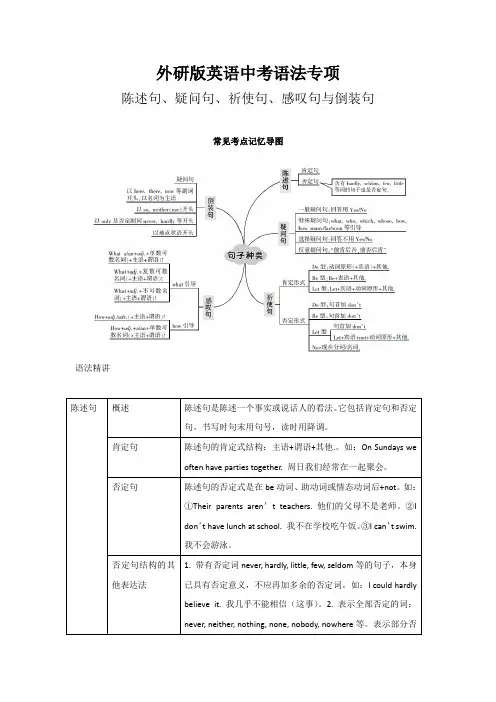
外研版英语中考语法专项陈述句、疑问句、祈使句、感叹句与倒装句常见考点记忆导图语法精讲实战演练一、根据句意完成下列句子1. (宁波中考)I don’t think many of us realize______________ lucky we are.2. You must think about______________ should be done first.3. —Hello, Jack!Haven’t seen you for long!I’m calling to check______________ you are.—Very well. Thanks.4. —Do you know______________ he exercised when he was a student?—Three or four times a week.5. —Do you know______________ he is going to stay in London?—Sorry, I don’t know. Maybe a few weeks, but I’m not sure.6. (嘉兴、舟山中考)They were surprised well the small cat seemed to get along with the large bear.7. She came to realize______________ she actually missed all of them.8. —______________ are you always staying up so late these days?—To prepare for my final exams.9. The robot can help me sweep the floor. smart invention it is!10. Look! Laura is going to finish in first place.______________ fast she runs!二、根据句意或汉语提示完成祈使句或倒装句1.______________ wake up your sister, Ben. She needs a good sleep.2.______________ (努力学习),______________ (否则你不会)pass the exam.3.______________ (驾驶)carefully, Michael! There’s a school ahead.4. Tree-planting Day is coming.______________ (让我们)grow some trees over there.5. —Tom has been to China before.—____________________________ (也去过)Mike.6. —He continued watching TV after the phone rang many times.—____________________________ (的确如此).7. —Li Ping wasn’t late for school this morning.—____________________________ (也没有)Tom.三、根据句意或要求完成句子1. —______________ can you finish the report on food safety?—In two days.2. —She doesn’t like pop music,______________ ?—No, she doesn’t.3. (重庆中考B卷)My aunt likes watching TV plays. (改为否定句)My aunt____________________________ watching TV plays.4. John runs very fast. No one can catch up with him in his class. (合并为一个句子)John runs______________ fast______________ no one can catch up with him in his class.5. Let’s discuss how can we get to the airport. (改为简单句)Let’s discuss____________________________ get to the airport.参考答案第35课陈述句、疑问句、祈使句、感叹句与倒装句实战演练一、1. how 2. what 3. how 4. how often 5. how long6. how7. how much8. Why9. What a 10. How二、1. Don’t 2. Study hard, or you won’t 3. Drive 4. Let’s5. So has6. So he did7. Neither was三、1. How soon 2. does she 3. doesn’t like 4. so, that5. how to。
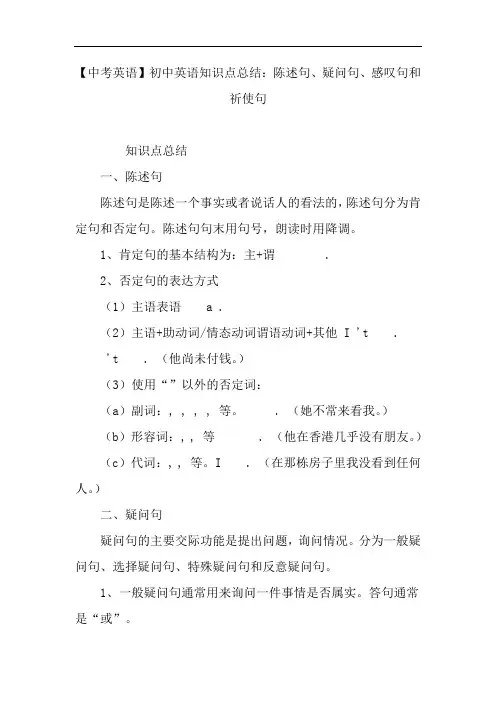
【中考英语】初中英语知识点总结:陈述句、疑问句、感叹句和祈使句知识点总结一、陈述句陈述句是陈述一个事实或者说话人的看法的,陈述句分为肯定句和否定句。
陈述句句末用句号,朗读时用降调。
1、肯定句的基本结构为:主+谓 .2、否定句的表达方式(1)主语表语 a .(2)主语+助动词/情态动词谓语动词+其他 I 't .'t . (他尚未付钱。
)(3)使用“”以外的否定词:(a)副词:, , , , 等。
. (她不常来看我。
)(b)形容词:, , 等 . (他在香港几乎没有朋友。
)(c)代词:, , 等。
I . (在那栋房子里我没看到任何人。
)二、疑问句疑问句的主要交际功能是提出问题,询问情况。
分为一般疑问句、选择疑问句、特殊疑问句和反意疑问句。
1、一般疑问句通常用来询问一件事情是否属实。
答句通常是“或”。
句型一: +主语+ …??这些书在桌子上吗?句型二: / / + 主语 +谓语+…??你喜欢英语吗?句型三:情态动词 + 主语 + 谓语+…?I ?我必须现在完成我的家庭作业吗?句型四: / + 主语 + 过去分词+…??你收到他的来信吗?另外,还有以动词、助动词或情态动词的否定缩写形式开头的一般疑问句,这种句子一般表示请求、惊讶和对事物的看法等,回答时所用的和表达的意思和汉语的习惯不同。
例如:——'t ?难道他不高吗?—— , .不,他很高。
2、特殊疑问句以疑问词开头,对句中某一成分提问的句子叫特殊疑问句。
常用的疑问词有:、、、、、、、等。
例如:?﹖3、选择疑问句提出两个或两个以上可能的答案供对方选择。
选择疑问句的两种或两种以上的情况用连接,不能用或回答,而是就其选择内容直接回答。
这类疑问句有两种形式:一种是:一般疑问句被选择部分?,这一类选择疑问句通常都是在前一个供选择的答案用低升调,后一个用降调;如果有两个以上供选择的答案,则在最后一个用降调,其余都用低升调。
例如: a , a , a `?你是要喝杜松子酒,还是威士忌酒,还是啤酒?另一种是:特殊疑问句+被选择部分(A)被选择部分(B)?也是在语调上有所区别。
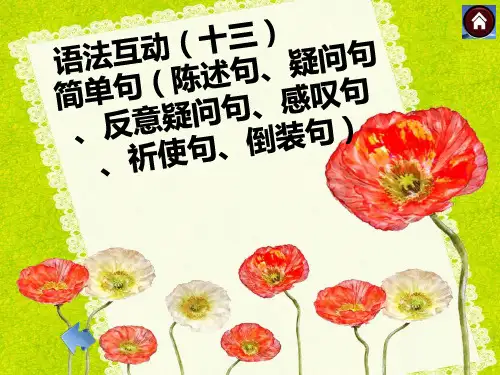
中考考点1 .陈述句的概念及其肯定形式和否定形式。
2.一般疑问句、特殊疑问句、选择疑问句、反意疑问句的结构及答语。
3.what 和how 引导的感叹句。
考点一陈述句陈述句用来说明一个事实或陈述说话人的看法。
陈述句主要分为肯定和否定两种形式。
1.陈述句的肯定句式主要有五种基本句型:(1)“主语+系动词+表语”,如:I am honored. 我很荣幸。
(2)“ 主语+不及物动词”,如:The students work very hard.学生们学习很努力。
(3)“主语+及物动词+宾语”,如:I teach English. 我教英语。
(4)“ 主语+及物动词+间接宾语+直接宾语”,间接宾语是人,直接宾语是物。
能接双宾语的动词多数要在间接宾语前加to, 有此用法的动词有give, send, pass, take, bring, show, lend, sell 等。
如:She sent me a present. =She sent a present to me.她寄给我一份礼物。
能接双宾语,要在间接宾语前加for 的动词有buy, make, build, mend, cook 等。
如:My father bought me a bike. =My father bought a bike for me. 我爸爸给我买了一辆自行车。
(5)“ 主语+及物动词+宾语+宾语补足语”,如:The teacher asked the students to listen carefully in class. 老师要求学生上课认真听讲。
2.陈述句的否定句式:(1)如果陈述句中含有be 动词、助动词或情态动词,那么在它们之后加not 便可构成否定句。
(2)如果陈述句中的谓语是行为动词,在谓语动词之前加do 的适当形式再加not 构成否定句。
如:I didn't pass the test. 我没有通过测试。
初中英语知识点汇总:陈述句、疑问句、祈使句、感叹句句子的类型(一)教学重点句子的类型:陈述句陈述句(包括肯定的或否定的)用来叙述一项事实。
陈述句的结构分为肯定结构和否定结构两种。
1、陈述句的肯定结构(1)主语与谓语的一致,句子中的谓语动词和主语在人称和数上必须一致。
如:I was having dinner when he came in.He is now working at a bank.①谓语只跟主语的中心词保持一致,修饰词不影响主语的数:The quality of this kind of bike is poor.There be结构和其他倒装句中,谓语通常放在主语的前面,这时谓语是单数还是复数,要依后面的主语而定,如:There is no milk in the bottle.There are no students iin the classroom.②“one of ……”结构作主语,谓语应该用单数。
如:One of the students is absent.Making things is a good activity.What hurt her most is his words.③由and连接两个或两个以上的名词,由“both…and…”连接的两个成分作主语,其谓语动词通常用复数形式,如:Susan and Sally like pop music.The worker and the peasant are going to give us a talk.④单数名词后面有下面词语修饰时,主语不受这些词或词组的影响with…. like…as well as…together with…He, as well as his classmates, likes popular songs.Mr Li, together with his wife and two songs, is on holiday these days.⑤由连词“either…or…”,“neither…nor…”,“not only…but also…”,also, nor, or连接两个名词或代词,谓语动词的形式应与最近的主语保持一致Neither I nor my brother is good at maths.Either you or I’m wrong.注意:表示数量、时间、距离、金钱等的复数名词作主语时,谓语动词一般用单数形式。
专题十二简单句┃陈述句┃陈述句是用于陈述事实和观点的句子。
包括肯定结构和否定结构。
肯定句变否定句的基本方法如下:1.be 动词的否定式:在be动词后面加否定词not。
如:We aren't classmates. 我们不是同学。
2.情态动词的否定式:在情态动词后面直接加否定词not。
如: I can't speak English well. 我英语说得不好。
3.实义动词的否定式:借助助动词do/ does构成。
一般现在时的句子结构为:主语+doesn't/don't +动词原形+其他。
如:He doesn't do exercise every day.他不是每天锻炼。
┃疑问句┃疑问句的主要交际功能是提出问题,询问情况。
分为一般疑问句、选择疑问句、特殊疑问句和反意疑问句。
1.一般疑问句:通常用来询问一件事情是否属实。
答句通常是“Yes”或“No”。
如:―Are you tired? ―Yes, I am.“你累吗?”“是的,我累。
” 2.选择疑问句:指提出两个或两个以上可能的答案供对方选择。
如: Shall we go home or stay here for the night? 我们回家还是待在这里过夜?专题十二简单句 3.特殊疑问句:以疑问词开头,对句中某一成分提问的句子叫特殊疑问句。
如: What do you like most? 你最喜欢什么? 4.反意疑问句:反意疑问句又叫附加疑问句,由两部分组成,前一部分是对事物的陈述即陈述句,后一部分是简短的提问即简短疑问句,中间用逗号隔开。
要遵循“前否后肯”、“前肯后否”的原则,且两部分的人称和时态要一致。
专题十二简单句中考中常见的反意疑问句的构成情况如下: 1 陈述部分为Let us…时,问句部分习惯上用“will you?”;陈述部分为Let‘s…时,
问句部分习惯上用“shall we?”如: Let us go to the cinema, will you? Let’s go to the cinema, shall we? 专题十二简单句 2 陈述部分为“There Here + be +主语”时,问句部分用“动词+there here ?”形式。
如: There are two cakes on the plate, aren't there? 3 反意疑问句的陈述部分带有little, few, never, hardly, seldom等否定意义的词时,问句部分用肯定式。
如: She seldom goes swimming, does she? 4 陈述部分的主语为指物的不定代词时,问句部分的主语用it。
如: Something is wrong with the computer, isn't it? 专题十二简单句 5 陈述部分的主语为指人的不定代词时,问句部分的主语用he或 they,这时问句动词的数应和he或 they一致。
如: Someone is knocking at the door, isn't he? 6 反意疑问句的陈述部分为“I We don‘t think believe, suppose, consider + that从句”时,问句部分的动词和主语仍与that从句保持一致且用肯定式。
如: I don't think that he has finished the work on time, has he? 专题十二简单句 7 反意疑问句的陈述部分含有由un-, im-, in-, dis-等否定意义的前缀构成的词语时,陈述部分要视为肯定含义,问句部分用否定形式。
如:It is unfair, isn't it? 8 陈述部分为肯定的祈使句时,反意疑问句部分可用will you/ won't you; 陈述部分为否定的祈使句时,反意疑问句部分只能用will you。
如: Don't make any noise, will you? 专题十二简单句┃祈使句┃祈使句是表示请求、命令、劝告、祝愿或建议的句子。
否定式是直接在动词原形前加don't。
常见的祈使句的基本句型如下: 1.动词原形+其他。
如: Be careful. 2.Do +动词原形加强语气。
如: Do be careful next time. 3.加please的祈使句表示更加客气和礼貌。
如: Open the door, please. 专题十二简单句┃感叹句┃感叹句一般用来表示说话时的喜悦、惊讶等情感。
英语感叹句常用what或how引导,句末用感叹号。
1.what引导的感叹句。
1 What+a/an+形容词+单数可数名词+主语+谓语!如:What a difficult question it is! 2 What+形容词+复数可数名词/不可数名词+主语+谓语!如:What useful information! 专题十二简单句 2.how引导的感叹句。
1 How+形容词/副词+主语+谓语!如: How kind they are! 2 How+陈述句主语+谓语!如: How time flies! 3.what 引导的感叹句可以和how引导的感叹句互换。
如: What a good girl! = How good the girl is! 专题十二简单句┃倒装句┃ 1.副词位于句首时。
here, there, now, then等副词置于句首时,谓语动词常用be, come, go, lie, run。
这种倒装的句型结构的主语必须是名词,如果主语是人称代词则不能完全倒装。
如: Here he comes. 他来了。
2.only在句首强调状语。
如: Only then did he realize that he was wrong.到那时他才意识到他错了。
专题十二简单句3.以so/neither/nor开头的句子。
此句型说明前面的内容也适用于后者,用倒装句“so/neither/nor+be/助动词/情态动词+主语”。
如: John can't swim, neither can I. 专题十二简单句专题十二简单句┃中考透视┃ 1. [2012?南充] ―________
weather! It's raining! ―Bad luck! We can't go climbing today.
A. What bad B.How bad C.What fine D.How fine A 此题考查what引导的感叹句:What +形容词+不可数名词! <div id="loadingAD"><div class="ad_box"><div class="waiting"><strong>文档加载中...</strong>广告还剩<em id="adtime"></em>秒。